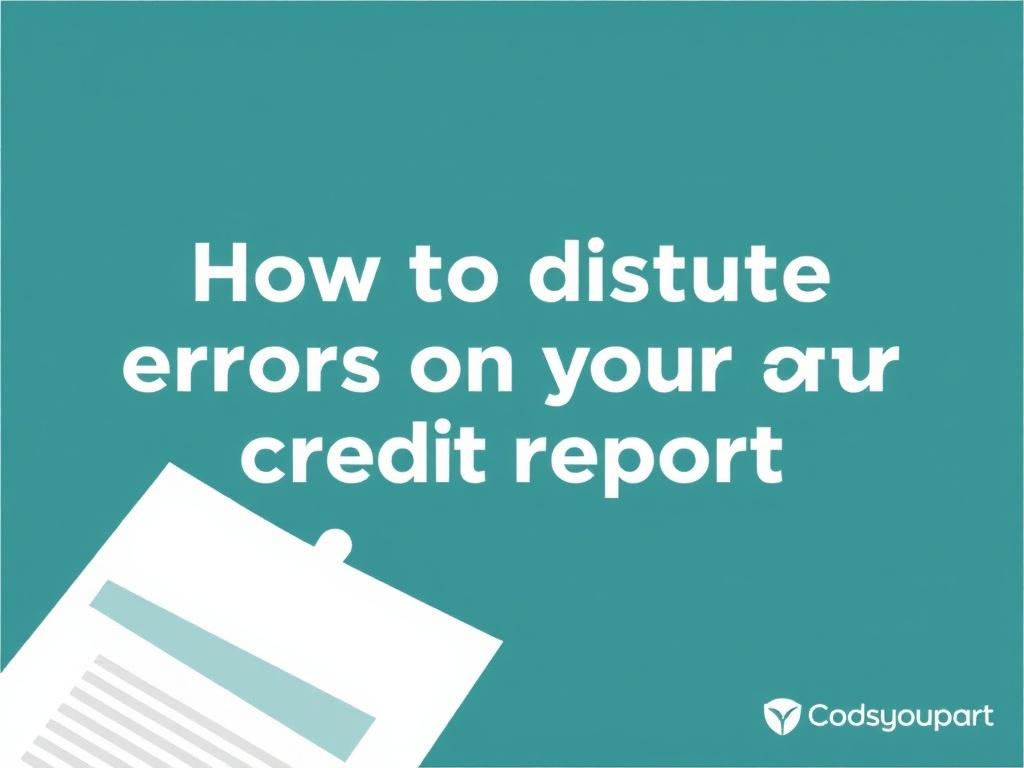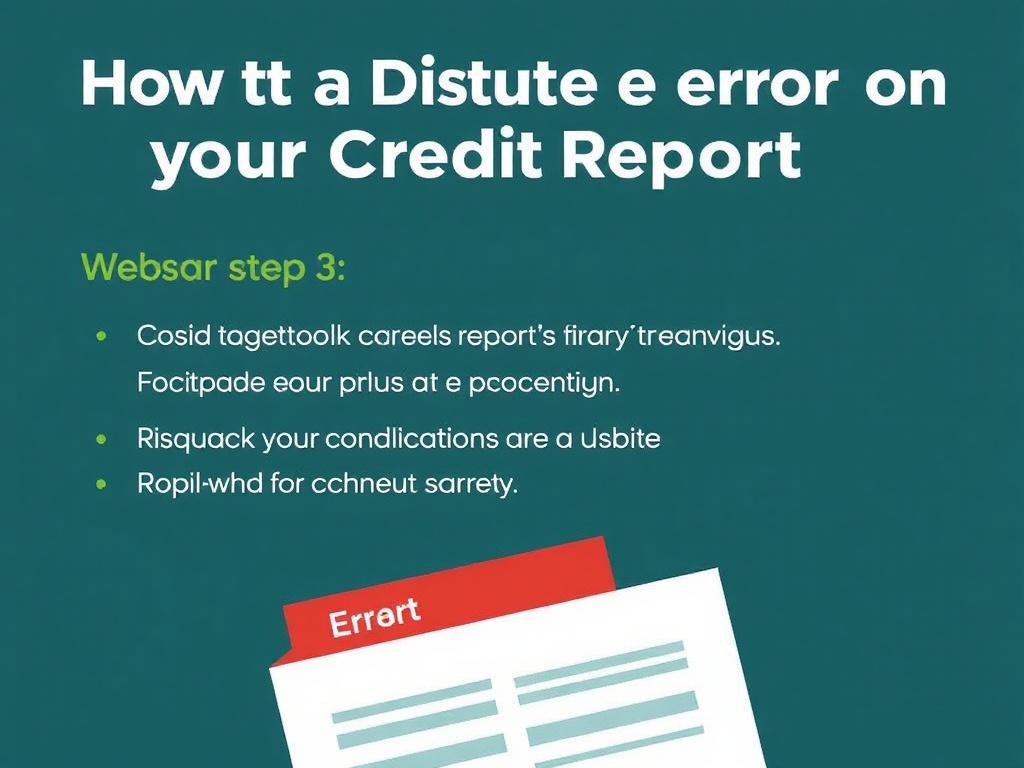SQLITE NOT INSTALLED
Discovering errors on your credit report can feel overwhelming and frustrating. Whether it’s an incorrect account balance, a payment marked late that was actually on time, or an unfamiliar account, these inaccuracies can really impact your credit score and financial health. The good news is you don’t have to accept these mistakes as permanent. Knowing how to dispute errors on your credit report is an essential skill for managing your financial well-being. In this comprehensive guide, we’ll walk you through every step you need to take, from spotting errors to getting them corrected. We’ll also break down important terms and give you practical tips for success.
Содержание
Understanding Your Credit Report: The First Step to Disputing Errors

Before you can dispute errors on your credit report, it’s vital to understand what your credit report actually contains. Your credit report is a detailed record of your credit history, issued by one of the major credit bureaus—Equifax, Experian, or TransUnion. It includes your personal information, a list of your credit accounts, payment history, inquiries from lenders, and public records like bankruptcies. Errors often arise because of outdated information, identity theft, or simple clerical mistakes.
When you’re learning how to dispute errors on your credit report, the first step is to get a copy of your credit report from all three major bureaus. Under federal law, you’re entitled to one free credit report from each bureau annually, which you can obtain at AnnualCreditReport.com. Reviewing all three ensures you catch any discrepancies that might appear on just one or two of the reports.
Common Types of Credit Report Errors
Knowing what kind of errors to look for makes the dispute process smoother. Here are some typical examples:
- Incorrect personal information (wrong name, address, Social Security number)
- Accounts that don’t belong to you (fraud or identity theft)
- Accounts listed more than once (duplicates)
- Incorrect account status (for example, reported as late when payments were on time)
- Outdated information (negative items older than seven years, or bankruptcies older than ten)
- Incorrect balances or credit limits
Step 1: Carefully Review Your Credit Report

After ordering your credit reports, set aside focused time to review them closely. Don’t rush—errors can be subtle. Here’s a checklist to follow:
| What to Check | Why It Matters | Examples |
|---|---|---|
| Personal Information | Ensures report belongs to you and is accurate | Name spellings, address, birth date, Social Security number |
| Credit Accounts | Verify all listed accounts are yours and correctly reported | Credit cards, loans, mortgages, collections |
| Payment History | Correct late payments or delinquencies | Check dates and statuses carefully |
| Inquiries | Unauthorized inquiries can affect score | Look for lenders you don’t recognize |
| Public Records | Bankruptcies, judgments, or liens must be accurate and timely | Check dates and case numbers |
Identifying errors in these sections helps target your dispute clearly.
Step 2: Gather Supporting Documentation
One vital part of how to dispute errors on your credit report is collecting evidence. When you file a dispute, the credit bureau will investigate your claim, but they rely on proof from both you and the furnisher (creditor or lender). Compiling relevant documents strengthens your case and increases the chance your dispute will be resolved swiftly.
Common examples of supporting documents include:
- Payment receipts or statements showing timely payments
- Letters or emails from your creditor correcting information
- Copies of your identification to prove identity
- Bank statements showing payments
- Police reports or fraud affidavits if identity theft is involved
Tip: Organize Documents Clearly
Keep a clear, labeled folder for each disputed item. Include a copy of the credit report page with the error circled or highlighted, and attach any evidence supporting your claim. Being organized will make the dispute smoother if you need to escalate the issue.
Step 3: File Your Dispute With the Credit Bureau

Once you have your evidence ready, you can file a dispute with the credit bureau reporting the error. Each bureau has an online dispute system, a mailing address for disputes, and a phone option. Filing online is often fastest and allows you to upload documents immediately.
How to Dispute Errors on Your Credit Report Online
Here are the links for the three major bureaus:
Be clear and concise in your description of the error. Here’s an example of how to phrase it:
“I am writing to dispute an inaccurate late payment reported on my account with [Creditor Name], account number [XXXX]. I have attached my bank statements showing payments were made on time for the months in question. Please investigate and correct this error.”
How to Dispute Errors by Mail
If you prefer mailing your dispute, sending a certified letter with “return receipt requested” is highly recommended. This gives you proof the bureau received your dispute, which can be useful if you follow up later.
Your dispute letter should include:
- Your full name, address, and date of birth
- A clear identification of the item you dispute (account name, number, or public record details)
- A clear explanation of why the information is incorrect
- A request to remove or correct the error
- Copies (not originals) of supporting documents attached
Here’s a sample template snippet:
Dear [Credit Bureau Name],
I am writing to dispute the following information in my credit report. The item I dispute is [describe item]. This information is inaccurate because [explanation]. I have enclosed copies of documents supporting my position. Please investigate this matter and correct the erroneous information.Thank you,
[Your Name]
Step 4: Wait for the Investigation Results
By law, credit bureaus have 30 days to investigate your dispute after receiving it. They will contact the creditor or organization reporting the information to verify accuracy. During this time, your report must show your dispute is being investigated.
You will receive the results of the investigation in writing once complete. If the error is confirmed, the bureau must promptly update or delete the disputed information. However, if the creditor verifies the information is correct, it may remain on your report.
Tips on What to Do After the Investigation
- If the error is removed, check your credit report again to confirm the update.
- If the item remains and you still believe it is wrong, you can request the addition of a statement of dispute on your report, or escalate the dispute to the creditor or legal avenues.
- Use the opportunity to contact the creditor directly to resolve discrepancies where possible.
Step 5: Dispute Errors With the Creditor Directly
Sometimes the easiest path to fix an error is to contact the original creditor or lender directly. If they acknowledge mistakes, they can notify the credit bureaus to update your report.
When disputing with a creditor, provide a detailed explanation, copies of your supporting documents, and ask for written confirmation that they will correct the information.
Example Creditor Dispute Letter Points
- Account and personal details for identification
- Exact nature of the error
- Supporting evidence of why the information is incorrect
- A request for correction within a specified timeframe
- A polite but firm tone seeking resolution
Dealing With Identity Theft and Fraud on Your Credit Report
Errors can sometimes be signs of identity theft, where someone uses your personal information to open accounts fraudulently. If you spot accounts or inquiries you don’t recognize, it’s critical to act quickly.
Steps to handle identity theft issues include:
- Placing a fraud alert or credit freeze on your credit files
- Filing a report with the Federal Trade Commission (FTC) at IdentityTheft.gov
- Reporting fraudulent accounts to the credit bureaus and creditors
- Filing a police report if necessary
Following these steps precisely can help limit the damage and get fraudulent information removed faster.
Tracking Your Disputes and Next Steps
Staying organized throughout the credit reporting dispute process is key. Keep copies of all disputes you file, responses you receive, and any follow-up communications. Keeping a dedicated log or journal can help when managing multiple disputes or following up on slow investigations.
If you encounter difficulty, you can escalate to the Consumer Financial Protection Bureau (CFPB) by filing a complaint online. The CFPB can intervene with credit bureaus or lenders to resolve more complicated disputes.
A Quick Reference Table for Dispute Channels
| Method | Where to File | Advantages | Disadvantages |
|---|---|---|---|
| Online Dispute | Credit bureau websites | Fast, easy, upload documents immediately | Requires internet access, limited interaction |
| Mail Dispute | Credit bureau mailing addresses | Proof of receipt, formal record | Slower processing time, requires postage |
| Phone Dispute | Credit bureau customer service numbers | Immediate confirmation, direct communication | No paper trail, harder to provide documentation |
| Direct Creditor Dispute | Creditor’s dispute department | May resolve issues faster | Varies by company responsiveness |
Preventing Future Credit Report Errors
While knowing how to dispute errors on your credit report is invaluable, prevention is just as important. Here are some practical tips to help you minimize errors in the future:
- Check your credit reports regularly—at least once a year.
- Sign up for credit monitoring services if possible.
- Be cautious about sharing personal information, especially online.
- Pay bills on time to avoid legitimate negative marks.
- Keep records of payments and communications with creditors.
By staying proactive, you can catch issues early and maintain a strong credit history.
Conclusion
Disputing errors on your credit report can feel daunting, but with a clear step-by-step approach, it becomes manageable and effective. Start by understanding your credit report inside and out, gathering supporting documents, and filing disputes with the appropriate credit bureaus or creditors. Being organized, patient, and persistent is key, especially when errors or fraudulent activities impact your financial reputation. Remember, taking the time to fix these mistakes can improve your credit score significantly, opening doors to better lending options, lower interest rates, and greater financial freedom. The power to maintain an accurate credit report is in your hands—use these strategies to protect your financial future.
Опубликовано: 23 July 2025 Кредитрон – блог о кредитах, финансах и прочих реверансах
Кредитрон – блог о кредитах, финансах и прочих реверансах

